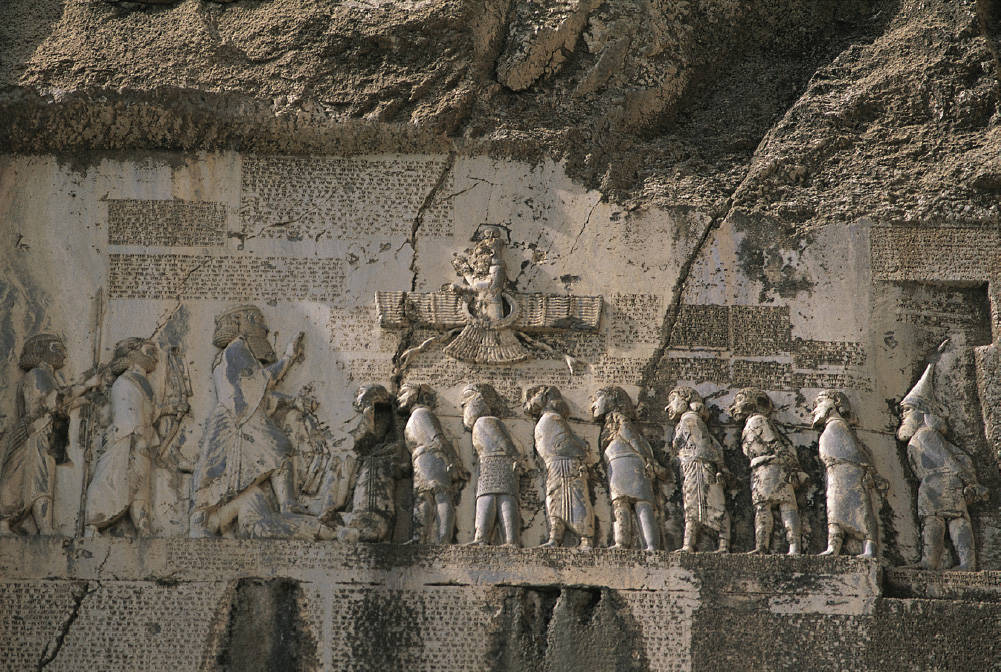Visual Source 3.1: Bihustun Inscription
From the Persian Empire comes an impressive visual representation of political power, part of a huge multilingual inscription located on a limestone cliff some 300 feet above the ground in western Iran. Known as the Behistun Inscription, this monumental work, shown here as Visual Source 3.1, was commissioned by the Emperor Darius the Great (r. 522–486 B.C.E.) to celebrate his many victories over foreign enemies and domestic rebels alike. Those victories were accomplished, as the inscription repeatedly asserts, “by the grace of Ahuramazda,” the great benevolent Deity of Zoroastrianism. Summing up his reign, Darius declared: “On this account Ahuramazda brought me help, and all the other gods, all that there are, because I was not wicked, nor was I a liar, nor was I a despot, neither I nor any of my family. I have ruled according to righteousness. Neither to the weak nor to the powerful did I do wrong. Whosoever helped my house, him I favored; he who was hostile, him I destroyed.”18
The central figure in the carving is Darius himself, the third from the left, holding a bow as a symbol of rulership with his foot on the chest of one of the rebels whom he had crushed. To the right stands a line of nine captives roped at the neck with their hands tied behind them, who represent other rebels or conquered peoples. To the left of Darius are two of his leading generals who have the honor of ritually carrying the monarch’s bow and lance respectively. Hovering over the entire scene is the Faravahar, the ancient Near Eastern winged disk symbol, which had come to represent Ahuramazda and the Zoroastrian tradition.

Question
ihbdk/t6MWVCDNS7egexrndvZwaxZp8aK0QRFZb7GVSriJI2+0vxofJPpQiDZIG9gqB3Pt+lu1WpB0DupVoKXsC5n1fSTO/bnmmImt93t97CKTz7Question
0hny7T5isY8ta5faCMFxnx1qR16pyv5Ixvr74QfLxGMwWEFtP/iQLQjQQKduAH9Ihh7AFYd2DmEaCVinK6IpG10+NqWHlNxRNg3HTdeKrB89BiT9Eg4WHVrvIKg=Question
P+QTidhZiW3iCg8mAWTVd15ufHEfexe+GoQJ6XkNj5Muswk3yNZp9b2SHuqizAbwfs9Spt81t5zZSKToHCKuyg==Question
rlgQgcRXxnrh9ko9ZAhucRpQ1OguoW3pNDzUj+F/GFsYPzaz0IfYmrgaBJ5Ozcew3L8Y/YIw1UJgYazisi5ex4MMsrmMsa/Tf4v6iylUZhUlC1y0yNrV0OdcW6Qwk5CF6TteKRrnmKXt27dWoZN7vTD7WgXNoOS3UES7wt+L2qCfuAaaKbjMtUVW99aEQWGXuw9NOrB5JUqw4BHunfDrlkDyXkyuvLPK8IcK8AGVi9oArSWVu+gu/S4MAX1BtpIMYnSWDWvahXM3EBwnzi0XNZHuM1AVGwzMzA5BUEU2qtzaIPRkxHVh1w==